Ziwei Zhang
RAP: Real-time Audio-driven Portrait Animation with Video Diffusion Transformer
Aug 07, 2025Abstract:Audio-driven portrait animation aims to synthesize realistic and natural talking head videos from an input audio signal and a single reference image. While existing methods achieve high-quality results by leveraging high-dimensional intermediate representations and explicitly modeling motion dynamics, their computational complexity renders them unsuitable for real-time deployment. Real-time inference imposes stringent latency and memory constraints, often necessitating the use of highly compressed latent representations. However, operating in such compact spaces hinders the preservation of fine-grained spatiotemporal details, thereby complicating audio-visual synchronization RAP (Real-time Audio-driven Portrait animation), a unified framework for generating high-quality talking portraits under real-time constraints. Specifically, RAP introduces a hybrid attention mechanism for fine-grained audio control, and a static-dynamic training-inference paradigm that avoids explicit motion supervision. Through these techniques, RAP achieves precise audio-driven control, mitigates long-term temporal drift, and maintains high visual fidelity. Extensive experiments demonstrate that RAP achieves state-of-the-art performance while operating under real-time constraints.
Invariant Graph Transformer for Out-of-Distribution Generalization
Aug 01, 2025Abstract:Graph Transformers (GTs) have demonstrated great effectiveness across various graph analytical tasks. However, the existing GTs focus on training and testing graph data originated from the same distribution, but fail to generalize under distribution shifts. Graph invariant learning, aiming to capture generalizable graph structural patterns with labels under distribution shifts, is potentially a promising solution, but how to design attention mechanisms and positional and structural encodings (PSEs) based on graph invariant learning principles remains challenging. To solve these challenges, we introduce Graph Out-Of-Distribution generalized Transformer (GOODFormer), aiming to learn generalized graph representations by capturing invariant relationships between predictive graph structures and labels through jointly optimizing three modules. Specifically, we first develop a GT-based entropy-guided invariant subgraph disentangler to separate invariant and variant subgraphs while preserving the sharpness of the attention function. Next, we design an evolving subgraph positional and structural encoder to effectively and efficiently capture the encoding information of dynamically changing subgraphs during training. Finally, we propose an invariant learning module utilizing subgraph node representations and encodings to derive generalizable graph representations that can to unseen graphs. We also provide theoretical justifications for our method. Extensive experiments on benchmark datasets demonstrate the superiority of our method over state-of-the-art baselines under distribution shifts.
GraphRAG-R1: Graph Retrieval-Augmented Generation with Process-Constrained Reinforcement Learning
Jul 31, 2025Abstract:Graph Retrieval-Augmented Generation (GraphRAG) has shown great effectiveness in enhancing the reasoning abilities of LLMs by leveraging graph structures for knowledge representation and modeling complex real-world relationships. However, existing GraphRAG methods still face significant bottlenecks when handling complex problems that require multi-hop reasoning, as their query and retrieval phases are largely based on pre-defined heuristics and do not fully utilize the reasoning potentials of LLMs. To address this problem, we propose GraphRAG-R1, an adaptive GraphRAG framework by training LLMs with process-constrained outcome-based reinforcement learning (RL) to enhance the multi-hop reasoning ability. Our method can decompose complex problems, autonomously invoke retrieval tools to acquire necessary information, and perform effective reasoning. Specifically, we utilize a modified version of Group Relative Policy Optimization (GRPO) that supports rollout-with-thinking capability. Next, we design two process-constrained reward functions. To handle the shallow retrieval problem, we design a Progressive Retrieval Attenuation (PRA) reward to encourage essential retrievals. Then, to handle the over-thinking problem, we design Cost-Aware F1 (CAF) reward to balance the model performance with computational costs. We further design a phase-dependent training strategy, containing three training stages corresponding to cold start and these two rewards. Lastly, our method adopts a hybrid graph-textual retrieval to improve the reasoning capacity. Extensive experimental results demonstrate that GraphRAG-R1 boosts LLM capabilities in solving complex reasoning problems compared to state-of-the-art GraphRAG methods on both in-domain and out-of-domain datasets. Furthermore, our framework can be flexibly integrated with various existing retrieval methods, consistently delivering performance improvements.
Marrying Autoregressive Transformer and Diffusion with Multi-Reference Autoregression
Jun 11, 2025Abstract:We introduce TransDiff, the first image generation model that marries Autoregressive (AR) Transformer with diffusion models. In this joint modeling framework, TransDiff encodes labels and images into high-level semantic features and employs a diffusion model to estimate the distribution of image samples. On the ImageNet 256x256 benchmark, TransDiff significantly outperforms other image generation models based on standalone AR Transformer or diffusion models. Specifically, TransDiff achieves a Fr\'echet Inception Distance (FID) of 1.61 and an Inception Score (IS) of 293.4, and further provides x2 faster inference latency compared to state-of-the-art methods based on AR Transformer and x112 faster inference compared to diffusion-only models. Furthermore, building on the TransDiff model, we introduce a novel image generation paradigm called Multi-Reference Autoregression (MRAR), which performs autoregressive generation by predicting the next image. MRAR enables the model to reference multiple previously generated images, thereby facilitating the learning of more diverse representations and improving the quality of generated images in subsequent iterations. By applying MRAR, the performance of TransDiff is improved, with the FID reduced from 1.61 to 1.42. We expect TransDiff to open up a new frontier in the field of image generation.
Controllable Logical Hypothesis Generation for Abductive Reasoning in Knowledge Graphs
May 27, 2025Abstract:Abductive reasoning in knowledge graphs aims to generate plausible logical hypotheses from observed entities, with broad applications in areas such as clinical diagnosis and scientific discovery. However, due to a lack of controllability, a single observation may yield numerous plausible but redundant or irrelevant hypotheses on large-scale knowledge graphs. To address this limitation, we introduce the task of controllable hypothesis generation to improve the practical utility of abductive reasoning. This task faces two key challenges when controlling for generating long and complex logical hypotheses: hypothesis space collapse and hypothesis oversensitivity. To address these challenges, we propose CtrlHGen, a Controllable logcial Hypothesis Generation framework for abductive reasoning over knowledge graphs, trained in a two-stage paradigm including supervised learning and subsequent reinforcement learning. To mitigate hypothesis space collapse, we design a dataset augmentation strategy based on sub-logical decomposition, enabling the model to learn complex logical structures by leveraging semantic patterns in simpler components. To address hypothesis oversensitivity, we incorporate smoothed semantic rewards including Dice and Overlap scores, and introduce a condition-adherence reward to guide the generation toward user-specified control constraints. Extensive experiments on three benchmark datasets demonstrate that our model not only better adheres to control conditions but also achieves superior semantic similarity performance compared to baselines.
Kill two birds with one stone: generalized and robust AI-generated text detection via dynamic perturbations
Apr 22, 2025

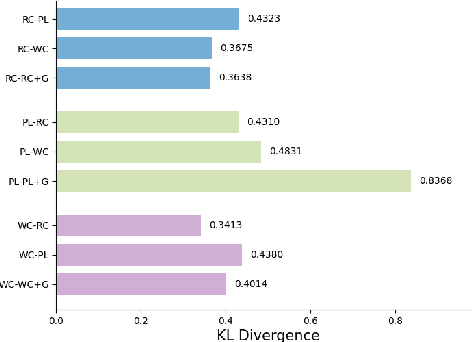

Abstract:The growing popularity of large language models has raised concerns regarding the potential to misuse AI-generated text (AIGT). It becomes increasingly critical to establish an excellent AIGT detection method with high generalization and robustness. However, existing methods either focus on model generalization or concentrate on robustness. The unified mechanism, to simultaneously address the challenges of generalization and robustness, is less explored. In this paper, we argue that robustness can be view as a specific form of domain shift, and empirically reveal an intrinsic mechanism for model generalization of AIGT detection task. Then, we proposed a novel AIGT detection method (DP-Net) via dynamic perturbations introduced by a reinforcement learning with elaborated reward and action. Experimentally, extensive results show that the proposed DP-Net significantly outperforms some state-of-the-art AIGT detection methods for generalization capacity in three cross-domain scenarios. Meanwhile, the DP-Net achieves best robustness under two text adversarial attacks. The code is publicly available at https://github.com/CAU-ISS-Lab/AIGT-Detection-Evade-Detection/tree/main/DP-Net.
BadApex: Backdoor Attack Based on Adaptive Optimization Mechanism of Black-box Large Language Models
Apr 21, 2025Abstract:Previous insertion-based and paraphrase-based backdoors have achieved great success in attack efficacy, but they ignore the text quality and semantic consistency between poisoned and clean texts. Although recent studies introduce LLMs to generate poisoned texts and improve the stealthiness, semantic consistency, and text quality, their hand-crafted prompts rely on expert experiences, facing significant challenges in prompt adaptability and attack performance after defenses. In this paper, we propose a novel backdoor attack based on adaptive optimization mechanism of black-box large language models (BadApex), which leverages a black-box LLM to generate poisoned text through a refined prompt. Specifically, an Adaptive Optimization Mechanism is designed to refine an initial prompt iteratively using the generation and modification agents. The generation agent generates the poisoned text based on the initial prompt. Then the modification agent evaluates the quality of the poisoned text and refines a new prompt. After several iterations of the above process, the refined prompt is used to generate poisoned texts through LLMs. We conduct extensive experiments on three dataset with six backdoor attacks and two defenses. Extensive experimental results demonstrate that BadApex significantly outperforms state-of-the-art attacks. It improves prompt adaptability, semantic consistency, and text quality. Furthermore, when two defense methods are applied, the average attack success rate (ASR) still up to 96.75%.
BotUmc: An Uncertainty-Aware Twitter Bot Detection with Multi-view Causal Inference
Mar 04, 2025Abstract:Social bots have become widely known by users of social platforms. To prevent social bots from spreading harmful speech, many novel bot detections are proposed. However, with the evolution of social bots, detection methods struggle to give high-confidence answers for samples. This motivates us to quantify the uncertainty of the outputs, informing the confidence of the results. Therefore, we propose an uncertainty-aware bot detection method to inform the confidence and use the uncertainty score to pick a high-confidence decision from multiple views of a social network under different environments. Specifically, our proposed BotUmc uses LLM to extract information from tweets. Then, we construct a graph based on the extracted information, the original user information, and the user relationship and generate multiple views of the graph by causal interference. Lastly, an uncertainty loss is used to force the model to quantify the uncertainty of results and select the result with low uncertainty in one view as the final decision. Extensive experiments show the superiority of our method.
Towards Lightweight Graph Neural Network Search with Curriculum Graph Sparsification
Jun 24, 2024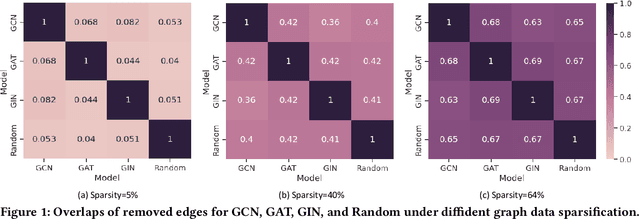

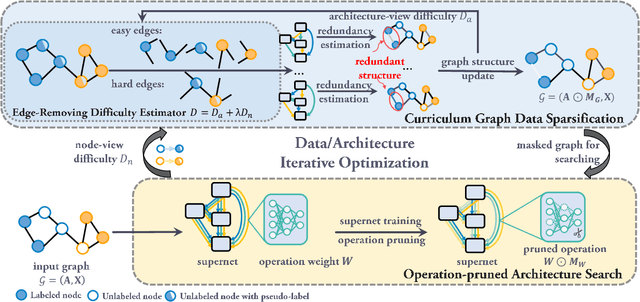

Abstract:Graph Neural Architecture Search (GNAS) has achieved superior performance on various graph-structured tasks. However, existing GNAS studies overlook the applications of GNAS in resource-constraint scenarios. This paper proposes to design a joint graph data and architecture mechanism, which identifies important sub-architectures via the valuable graph data. To search for optimal lightweight Graph Neural Networks (GNNs), we propose a Lightweight Graph Neural Architecture Search with Graph SparsIfication and Network Pruning (GASSIP) method. In particular, GASSIP comprises an operation-pruned architecture search module to enable efficient lightweight GNN search. Meanwhile, we design a novel curriculum graph data sparsification module with an architecture-aware edge-removing difficulty measurement to help select optimal sub-architectures. With the aid of two differentiable masks, we iteratively optimize these two modules to efficiently search for the optimal lightweight architecture. Extensive experiments on five benchmarks demonstrate the effectiveness of GASSIP. Particularly, our method achieves on-par or even higher node classification performance with half or fewer model parameters of searched GNNs and a sparser graph.
Causal-Aware Graph Neural Architecture Search under Distribution Shifts
May 26, 2024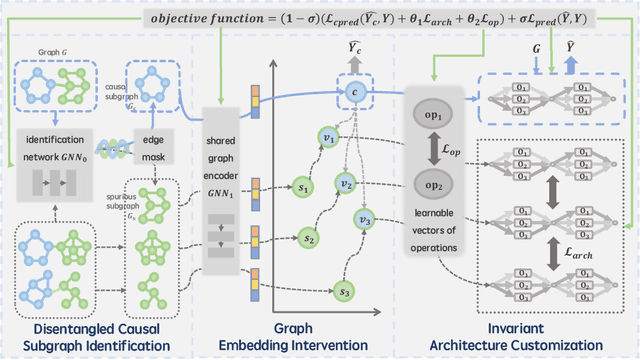
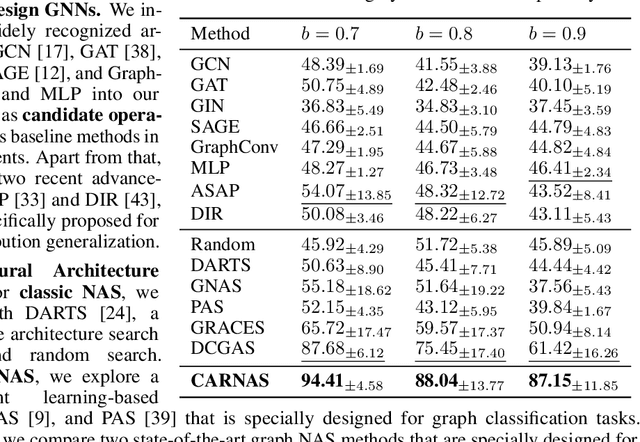
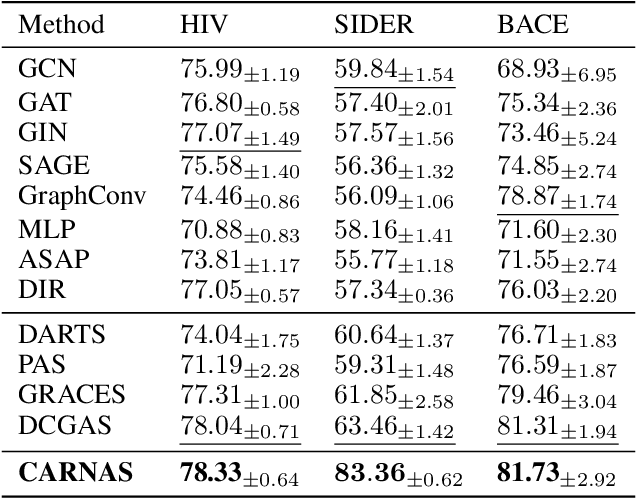
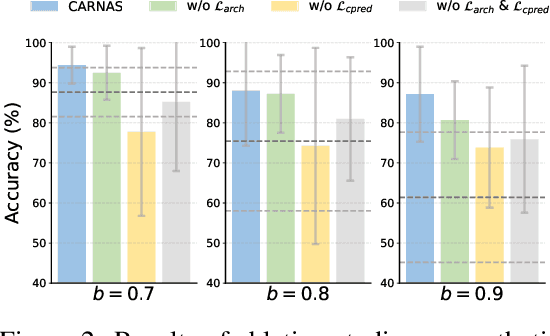
Abstract:Graph NAS has emerged as a promising approach for autonomously designing GNN architectures by leveraging the correlations between graphs and architectures. Existing methods fail to generalize under distribution shifts that are ubiquitous in real-world graph scenarios, mainly because the graph-architecture correlations they exploit might be spurious and varying across distributions. We propose to handle the distribution shifts in the graph architecture search process by discovering and exploiting the causal relationship between graphs and architectures to search for the optimal architectures that can generalize under distribution shifts. The problem remains unexplored with following challenges: how to discover the causal graph-architecture relationship that has stable predictive abilities across distributions, and how to handle distribution shifts with the discovered causal graph-architecture relationship to search the generalized graph architectures. To address these challenges, we propose Causal-aware Graph Neural Architecture Search (CARNAS), which is able to capture the causal graph-architecture relationship during the architecture search process and discover the generalized graph architecture under distribution shifts. Specifically, we propose Disentangled Causal Subgraph Identification to capture the causal subgraphs that have stable prediction abilities across distributions. Then, we propose Graph Embedding Intervention to intervene on causal subgraphs within the latent space, ensuring that these subgraphs encapsulate essential features for prediction while excluding non-causal elements. Additionally, we propose Invariant Architecture Customization to reinforce the causal invariant nature of the causal subgraphs, which are utilized to tailor generalized graph architectures. Extensive experiments demonstrate that CARNAS achieves advanced out-of-distribution generalization ability.
 Add to Chrome
Add to Chrome Add to Firefox
Add to Firefox Add to Edge
Add to Edge